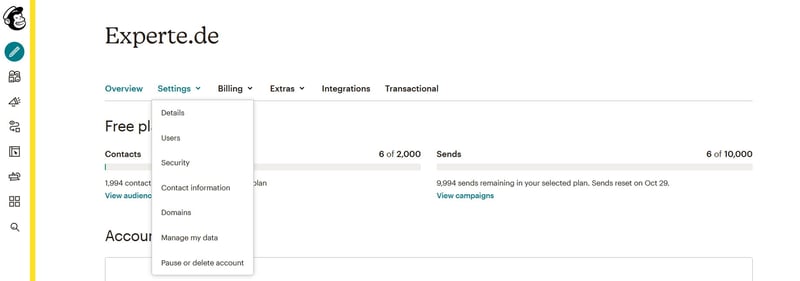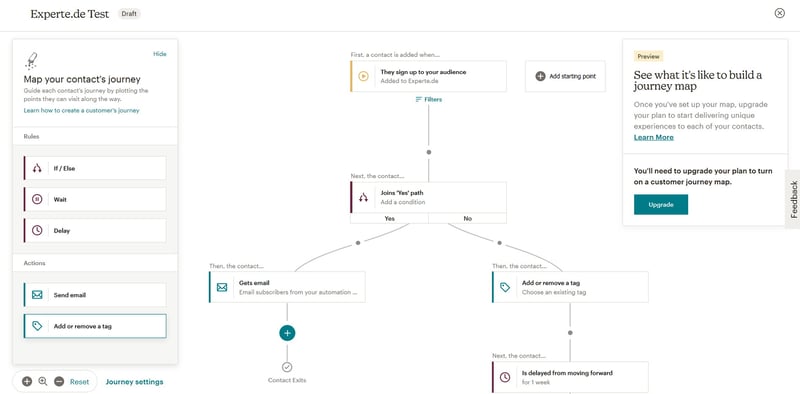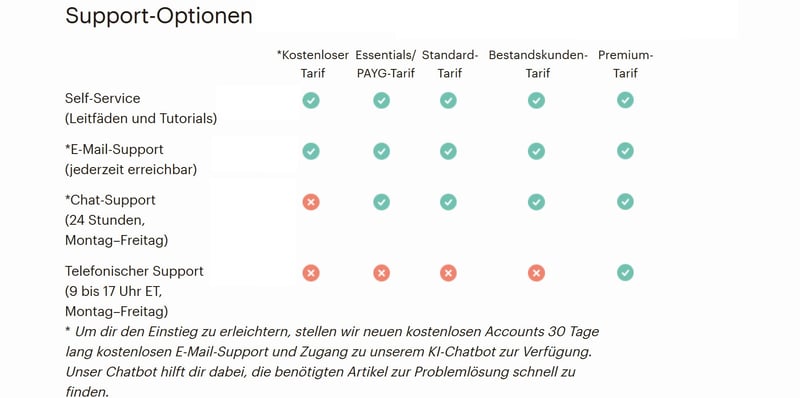There's no better way to stay in touch with your customers and site visitors than with the aid of email marketing tools and services. These serve as a central hub for planning and launching online marketing strategies, helping you gather new subscribers, optimize existing campaigns, and reach your target audience.
Thanks to the variety of solutions on the market, it has become difficult to decide which service is best for your business or organization. In this review, we'll let you know if Mailchimp is a serious option worth your time and money, or just monkeying around.

What is Mailchimp?
Mailchimp* is an email marketing tool from the US which has grown over recent years to become one of the leading service providers. Particularly for those on a budget, Mailchimp is often the first port of call, since its free version allows users to save up to 2,000 subscriber addresses, and send 10,000 emails per month. This generosity is one of Mailchimp's major advantages over its competitors.
The company was founded in 2001, and as such, is one of the first platforms to offer newsletter automation and email marketing. It's easy to see why Mailchimp's mascot (a winking chimp) is so happy: With its 12.3 million users, and 11,000 new accounts per day, the service accounts for around 60% of the worldwide market.
On paper, Mailchimp is already impressive, however, we're going to look beyond the facts and figures in this review and make sure that there isn't any monkey business going on (and of course, use plenty of monkey puns along the way).
Review
Pros and Cons
Generous free version which allows sending of up to 10,000 emails (per month) and saving 2,000 recipients
Wide selection of design templates and builders
Good workflow builder for automated mailings
Numerous integration options for websites
Innovative adoption of site design through the service's Creative Assistant
Only ticket support available to free users
Ensuring GDPR-compliance somewhat cumbersome
Configuration & Usage
Setting up Mailchimp for the first time is a breeze. If using the free version, you won't need to input any payment information. As with most services, the email address that you register with is automatically saved as your verified sender address, allowing you to start mailing right away.
In the dashboard, you're taken through the service, step-by-step, and shown how to easily integrate it with your existing website or store.

Mailchimp's dashboard.
Should you want to use Mailchimp for transactional emails that are linked to specific events or activities in your webstore, we recommend configuring this in the interface first. Doing so is made particularly easy thanks to the presence of an abundant selection of plugins for services like WordPress, WooCommerce, Shopify, Drupal, Facebook, or Magento.
Mailchimp also provides its own API.

Under Settings in the menu, it's possible to register a unique domain. Mailchimp makes the necessary DNS entries available, supporting SPF, DKIM, SenderID, and DomainKeys.
Along with integrations, you can also activate transactional emails, however, if using the free version, you'll only be able to send 500 test emails before being asked to pay. If you've booked a paid subscription, you'll be able to add additional users, whereas, in the free version, you're limited to a single user.
There isn't a whole lot more to do before launching your first campaign.

Mailchimp's settings.
Mailchimp's dashboard is well-organized, providing quick access to the most important features and functions through the self-explanatory symbols in the navigation bar on the left. Finding exactly what you're looking for will take a bit of time at first, however, the learning curve isn't steep at all.
In the past, Mailchimp's support for GDPR-compliance was not particularly good. Thankfully, this has improved somewhat, however, it continues to be difficult to ensure adherence to certain guidelines, evidenced by the lack of clear settings for tracking. In addition, Mailchimp's servers are based in the US, which means that GDPR-compliance isn't exactly the company's top priority.
All in all, after the last paragraph, you might think that we're being a bit too harsh on the jovial yellow monkey. Mailchimp's site does provide relevant information and tutorials detailing how to go about ensuring GDPR-compliance. These explain, for example, how to integrate elements of GDPR into your forms, manage user data, or activate double opt-ins. The last of these refers to the need for newsletter subscribers to confirm their subscription on two separate occasions.
The variety of features offered by Mailchimp is solid, and the service does make a number of informative tutorials available, showing how to execute more complex and advanced processes.
Score: 4.3 / 5
Adding Contacts
Contact information can be imported to Mailchimp in two ways:
Uploading a file containing it (CSV or TXT), or
Through copy-pasting it
After you've created your first list of contacts, it is possible to manually add addresses or other information to it, such as individual fields or segmentation for different groups of subscribers. Mailchimp's contact management system is exemplary.

Importing contacts in Mailchimp.
Mailchimp's form builder is well-designed and provides a nice outlet for personalizing subscription widgets for your site. Alongside classic forms, such as tables, you also have the ability to create embedded HTML, or pop-up forms as well. For the latter, an extensive builder that includes a number of different design templates is made available, with paying subscribers given access to an even wider range of templates.

Creating forms in Mailchimp.
The form builder suffers slightly from its lack of drag and drop functionality, which is common to most other providers, however, the possibilities which it offers are still nothing to frown at, and considering how easy and intuitive it is to use, we really can't complain.

Mailchimp's form builder.
By clicking on Website in the menu, you'll be able to create landing pages that can be used to gather contacts. In addition, you can also link your domain here, or buy a unique domain directly from Mailchimp.
A number of design templates are available for landing pages, even in the free version.

Mailchimp's design templates for landing pages.
The landing page builder is structured similarly to the form builder. We were most taken with its ease of use and variety of options. Again, the only drawback is the lack of drag and drop functionality, which makes the builder less intuitive than it could be.

Mailchimp's landing page builder.
One feature unique to Mailchimp is its Creative Assistant, which makes finding suitable designs and images, or automatically creating forms and websites particularly easy, especially for beginners.
The Creative Assistant reads design information directly from your website and automatically adds colors, logos, and background images to create visually-appealing layouts, which you can later fine-tune to your heart's content. During testing, this worked surprisingly well, yielding professional-looking results with a single mouse click.

Mailchimp's Creative Assistant.
Mailchimp comes with a significant number of professional, efficient, and user-friendly tools for managing contacts and subscribers. Thanks to the innovative Creative Assistant, making high-quality forms, surveys, and landing pages is hassle-free. However, what's most striking is that all of these features are provided in the service's free version. As such, Mailchimp is definitely 'king of the jungle' in terms of contact management.
Score: 5 / 5
Sending Emails
Once you're ready to create a mailing campaign, you can select Campaigns or Automations from the menu and choose from the following options:
Email (classic newsletters, A/B testing, autoresponders)
Customer Journey (for automated campaigns and workflows)
Ad (for social media and retargeting ads)
Postcard (for directly interacting with customers through physical postcards)
Classic campaigns are simple to launch, and you're given the choice between creating HTML emails from scratch or selecting from a number of different templates. For the latter, even in its free version, Mailchimp provides an excellent assortment to choose from.

Mailchimp's wide selection of newsletter templates.
The campaign builder does allow you to customize your communications but, like the form builder, also suffers from the absence of drag and drop functionality. The wide selection of templates and the Creative Assistant more than offset this, and, as a result, creating a professional newsletter isn't all that difficult.

Mailchimp's campaign builder.
In the past, Mailchimp had some issues in regards to automation, however, as of the time of writing, it appears that they've been rectified. The service makes a wide variety of automation possibilities available, as well as templates that can be used for different purposes. What's even more impressive though, is that you can automatically generate newsletters that mesh nicely with your existing site or store design.

Automations in Mailchimp.
The workflow builder is also worth mentioning since it enables users to create automated campaigns and nodes, as well as set conditions, helping to bring complex processes to life.
It's also one of the few builders included with Mailchimp that has drag and drop functionality, making it easy to add autoresponders to campaigns or link them to specific conditions. You can also automatically assign tags to specific user groups, or segment them. Unfortunately, transactional emails cannot be created using this builder.

Mailchimp's workflow builder.
Users of the free version aren't able to perform A/B testing during campaigns. This means that you'll need to book a paid subscription to compare and optimize your campaigns.
Transactional emails can be created, but not through tags and the regular builder. Instead, you'll have to use Mailchimp's Mandrill developer platform, which is accessible through a separate interface in Mailchimp's dashboard. To trigger transactional emails, such as through a purchase in your webstore, you'll need to link the service to your domain and use Mailchimp's API integration. For those lacking background knowledge in programming, this might be difficult.

Creating a transactional email in Mailchimp requires use of Mandrill.
You can also start an advertising campaign by clicking on Ad in the menu. When combined with Google Analytics, Facebook, or Instagram, this can nicely complement your mailing activity.

Taken together, Mailchimp provides users with a wide range of options in regards to sending emails. Launching a simple campaign is very straightforward, and definitely accessible enough for beginners. At the same time, creating transactional emails is made unnecessarily complicated and involves using an add-on program, Mandrill. Although Mailchimp doesn't make a mess of things, some providers offer more intuitive solutions for sending transactional emails.
The builders which the service provides are impressive: Deliverability, functionality, and user-friendliness are all top of the line, allowing pretty much anyone to create, edit, and launch an automated campaign or newsletter, even without any prior knowledge or experience.
Score: 4 / 5
Tracking & Statistics
As far as statistics are concerned, Mailchimp makes a strong showing, providing users with access to all important campaign information in a single, centralized location. By clicking on Campaigns -> Reports you're afforded an overview of your campaigns, including their open and click rates. Through View Report, you can pore over more detailed statistics for individual campaigns.

Statistics in Mailchimp.
In the detailed overview, you're provided with further information about bounces, clicked links, cancellations, deliverability, and more. Addresses that hard bounce your messages are automatically deactivated in your contact list, while Mailchimp gives soft bounces three days for delivery. Should sending fail across multiple campaigns, those addresses are deactivated in the contact list.

Mailchimp's tracking and statistics.
Mailchimp doesn't disappoint in terms of tracking and statistics, providing access to the most important data in a clear and informative manner. Our only (small) bone to pick is that detailed information, such as the subscriber's location, is only made available to paying subscribers. With that said, we can't criticize much else here.
Score: 5 / 5
Support
For free users, Mailchimp offers a chatbot system, as well as email support. The latter of these answered our query after 10 hours, which isn't all that bad, especially considering some providers don't offer free users any human support at all. On top of that, the answer we received was cordial and informative, with viable solutions offered to our issues.
The chatbot works surprisingly well, providing links as well as answers to all sorts of questions. There definitely isn't a chimp banging on the keyboard!

Mailchimp's support chatbot.
Starting with the "Essentials" subscription, 24/7 live chat support is offered, while hotline support is only available for "Premium" subscribers.

Mailchimp support comparison.
The best features of Mailchimp's customer service are limited to paying subscribers. Free users will have to rely on support emails and the chatbot, which isn't bad, but not exactly excellent either.
Score: 3.7 / 5
Pricing
Mailchimp stands out owing to its highly functional free version, which allows users to send up to 10,000 emails per month to 2,000 recipients. Few providers can compete, with some maxing out at half as much capacity in their own free versions. If you can live with Mailchimp watermarks under your widgets and emails, and some limitations in terms of functionality, it's likely that the free version can help you do everything that you're planning on.
Mailchimp's monthly prices are largely based on the number of subscribers and emails that you're planning to send. In the table below, we've listed these rates for you to help compare Mailchimp's performance to that of its competitors:
| Contacts / Provider | 500 | 1,000 | 5,000 | 10,000 ▲ | 50,000 | 100,000 |
|---|---|---|---|---|---|---|
| AWeber | $0 | $26 | $46 | $66 | - | - |
| Mailchimp | $0 | $0 | $50 | $75 | $259 | $499 |
| Constant Contact | €18 | €40 | €57 | €83 | €292 | - |
| Campaign Monitor | €9 | €29 | €49 | €99 | €329 | - |
| CleverReach | €15 | €20 | €55 | €100 | €400 | €900 |
| ConvertKit | $0 | $0 | $79 | $119 | $379 | $679 |
| ActiveCampaign | $15 | $29 | $89 | $139 | $299 | $459 |
| Klaviyo | $20 | $30 | $100 | $150 | $700 | $1,200 |
| Sendinblue | $0 | $0 | - | - | - | - |
| MailerLite | $0 | $0 | - | - | - | - |
| Mailjet | $0 | $0 | - | - | - | - |
When you consider that the difference between the free version and the cheapest "Essentials" paid subscription is only 500 recipients and that prices quickly rise as your subscriber list grows, it's difficult to comment upon the service's price-performance ratio. Compounding this is that with the "Essentials" subscription, you can only send 10 emails per month (this rises to 12 emails per month in the somewhat more expensive "Standard" subscription), and that a flat-rate isn't offered. Whether Mailchimp is right for you, depends largely on your sending behavior and goals.
| Free | Essentials | Standard | |
|---|---|---|---|
| Monthly Price | $0.00 | from $9.99 | from $14.99 |
| Contract Period (Months) | 0 | 1 | 1 |
| Limits | |||
| Contacts | up to 2,000 | up to 50,000 | up to 100,000 |
| Emails | up to 10,000 | up to 500,000 | up to 1,200,000 |
| Features | |||
| Segmentation | ✓ | ✓ | ✓ |
| Tagging | ✓ | ✓ | ✓ |
| Marketing Automation | ✓ | ✓ | ✓ |
| Ad Free | ✗ | ✓ | ✓ |
| Open-Rate Tracking | ✓ | ✓ | ✓ |
| Click Tracking | ✓ | ✓ | ✓ |
| A/B-Testing | ✗ | ✓ | ✓ |
Conclusion
Should you send less than 10,000 emails per month, and be able to handle a friendly-looking black and yellow monkey at the footers of your messages, Mailchimp easily apes the competition (we said there'd be more monkey puns). For companies or larger organizations, the variety of functions, automation options, and integrations with existing systems or platforms definitely make the service worth taking a closer look at.
Mailchimp doesn't suffer from any major or significant flaws, but the lack of drag and drop functionality in most of its builders, and the somewhat cumbersome implementation of GDPR-compliance are less than stellar in our opinion.

Customer Reviews
In the section below, we've compiled ratings provided by Mailchimp's users that were gathered from a variety of different sites and sources. Through these, you can gain a solid impression of how customers rate the provider.
Alternatives
If you're looking for an equally feature-rich free service, we can recommend CleverReach. The German provider impresses in particular thanks to its high degree of user-friendliness, extensive plugins, and integration options.
ActiveCampaign is another interesting alternative for anyone on the hunt for a good CRM and marketing solution. Its statistics, templates, plugins, and options for automation are as extensive as those of Mailchimp, albeit, without the advantage of a free version.










